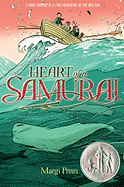
Preus (The Legend of the Lady Slipper) takes readers on a page-turning, salty adventure based on a true story about bridging a cultural and geographic divide. A group of Japanese fisherman, blown way off course by a storm at sea, winds up on a deserted island in the Pacific in 1841. They are rescued by barbarians--Americans aboard a whaling ship called the John Howland. The story unfolds through the eyes of Manjiro, who is 14 at the time of the rescue, and whose curious nature and open-mindedness convince him that he would be well-suited to the life of a samurai. In Japan in the 19th century, however, a boy born to a fisherman carries on as a fisherman, as does his son and his son after him. But when Manjiro proves himself an able seaman, Captain Whitman invites the boy to return to America with him and be raised as his son. At that time, the Japanese believed that those who went too far offshore should be imprisoned, and for Manjiro (whom crew members name John Mung), the captain's offer is one he cannot refuse--especially after he asks the boy, "What are your hopes and dreams?"
Through Manjiro's perspective, we see the differences between the two cultures, as well as the values they share. At the beginning of his journey with the American whalers, Manjiro notes, "These were certainly barbarians if they killed animals to make shoes! Such a thing was against the law in Japan." Yet much later, when Manjiro finds himself in the position of harpooning a whale, "he remembered how repulsed he'd been that these foreigners could kill so cruelly." His ability to reflect on his own actions and to judge himself by the same standards by which he measures others earn him the respect of not only his fellow shipmates but also of the New England townsfolk where he makes his home with Captain Whitfield. "Americans and the Japanese, when you boiled it down, were more alike than they would ever admit," Manjiro thinks. "They both thought they were better than other people--and each thought they were better than the other!" Part One begins with a quote from the Samurai Creed, and the remaining parts open with quotes from Hagakure: The Book of the Samurai. We watch the fisherman's son fulfill his own seemingly grandiose claims in both attitude and outlook: Manjiro "had encountered both beauty and pain. Now he understood that was how it would always be--no matter where he went in the world." Preus makes a compelling case for the evolution of the teen who would grow up to play such a pivotal role in the changing of Western attitudes toward Japan, and Japan's attitudes toward the West. Beautifully written and liberally illustrated with Manjiro's own drawings, this impressive novel charts not only a boy's coming of age, but also two countries edging closer to enlightenment.--Jennifer M. Brown

